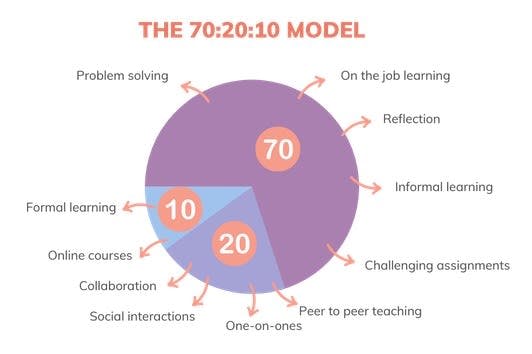70 20 10 Learning Model

If you are after the tl;dr (too long; didn’t read) version of the 70 20 10 learning model and learning experience and how it relates to our current corporate landscape, then look no further.
You don’t need to be a neuroscientist to figure out that we learn best by doing. In the old days, we have known that taking a learner-centered approach is important when it comes to the learning environment and developing pathways of deep understanding. As the ancient Chinese philosopher, Confucius (551 BC to 479 BC) declared,
In the learning and development space, the 70 20 10 learning model encapsulates this action-based learning approach and remains one of the most widely accepted frameworks for corporate training. Developed in 1996 out of a survey conducted by Morgan McCall, Robert Eichinger, and Michael Lombardo from the Center for Creative Leadership, the model differentiates learning modalities in the workplace. It gives prevalence to learning by experience (70%), followed by social interactions (20%) and formal education (10%).
A Beginner’s Guide to The 70 20 10 Learning Model
When it comes to learning and training in the workplace, the 70 20 10 learning model highlights the limitations of lecture-only learning process and instruction. To maximize learning and development investments like learning technology, particular focus should be given to the experiential portion of the 70/20/10 learning model budget. At the risk of oversimplifying the model and instructional design, a golden formula to follow is high relevance = increased engagement and retention. The very nature of experiential learning being learner-focused and integrated into the day-to-day operations of our work ensures relevance in the organic nature of the learning, leading to higher engagement and retention.

To hone in on the 70% proportion of experiential training, it is essential to have an understanding of what each of the modalities looks like within the learning model.
Experiential learning ‘by doing’ may include:
- Working on challenging problems
- Processes of active reflection
- ‘On the job’ work
- Informal learning experiences
- Experience-based learning
- Gamification of learning
- Online simulations
- Virtual reality
Social learning may include:
- Professional networks
- Social interactions
- One-on-ones
- Mentoring/coaching
- Peer to peer teaching
- Collaboration
- Discussion forums
- Social media
Formal learning may include:
- Lectures
- Instructional videos
- Online eLearning modules
- Textbooks
- Learning software
A word of warning – the 70 20 10 model is not an either/or learning model. Despite the neat rule of thumb, focusing on the different domains in isolation, or neglecting social and formal learning, is not necessarily an effective learning and development strategy. With the benefit of hindsight, Morgan McCall flagged misinterpretations of the theory and clarified how it could be used to unlock positive learning outcomes. McCall argued that formal learning programs, peer teaching, and coaching should not be used as ‘stand-alone interventions’ for active learning. Instead, he argued that ‘the best use of all three is in support of on-the-job development, most especially in real-time as job experiences unfold.’ Experts on learning and organizational psychology (see Whelan and Duvernet, 2018) have since weighed in on the learning model through new quantitative and qualitative data that has given slightly more weight to social and formal learning (increasing to roughly 25 and 20 percent, respectively).
It is also important to view the original 70/20/10 learning model in its historical context and adjust it according to current training technologies. Back in 1996, when McCall, Eichinger, and Lombardo came up with the 70 20 10 model, smartphones were the stuff of sci-fi fantasies. Now, with the microlearning revolution upon us, we are more empowered than ever to deliver a blended learning approach. Native smartphone microlearning platforms, such as the award-winning EdApp, provide the convenience of mobile-first learning while incorporating all the benefits of social and experiential learning.
Implementing a 70 20 10 methodology with EdApp
With EdApp, it’s possible to have the best of both worlds to facilitate a blend of all three learning modalities in the 70 20 10 rule. EdApp not only delivers online modules and corporate learning subject-matter in a convenient mobile learning management system, but our microlearning methodology and elearning development embrace a model of just-in-time, on-the-job learning that characterizes the experiential realm of 70-20-10 learning model. There’s also no need for an instructional designer in order for you to provide engaging content
Microlearning—that is, learning in short, relevant bursts of mobile-responsive content—is a far cry from the tedious PowerPoint presentations of yesteryear or traditional eLearning in the form of unwieldy MOOCs (Massive Open Online Courses). Microlearning can help achieve performance-based learning objectives that have day-to-day relevance for employees and garner greater engagement and higher retention, increasing knowledge and skills acquisition in employee training.

Features like Rapid Refresh allow instructors the flexibility to deliver curated quizzes to teams ‘just-in-time’ to maximize relevance and receptivity. It also helps address knowledge gaps and reinforce key competencies by revisiting previously learned content. Unlike traditional instruction, EdApp is not about delivering once-off interventions (which, let’s face it, have a pretty short memory lifespan before plunging into the abyss of the forgetting curve). With features like Brain Boost, content is reinforced by repeatedly exposing users to previously learned content at increasingly spaced intervals.
To extend users into the dynamic of ‘learning through doing,’ AKA the 70% rule, lessons can be followed up with assignments that can be either marked by peers or instructors. Such tasks challenge learners to reframe knowledge into their own words to demonstrate understanding. This process of active transformation works wonders for solidifying initial understandings.
We also believe that learning is more memorable when it is fun. Again, tapping into the experiential learning model, EdApp provides options to integrate gamified learning into any course through our easy-to-use game template library. Particularly when it comes to product knowledge, sequencing, or learning subject-specific terminology, games such as The Elevator Game or Jeopardy are sure to satisfy even the most discerning Wordle addict. Motivation is further boosted when you add an element of social competition through leaderboards and allow learners to earn ‘star’ reward points for real prizes.
Our discussion forums, which facilitate peer-to-peer or peer-to-instructor conversations, are an engaging way to incorporate social and collaborative learning (the 20% of 70 20 10) into your team. More casual than assignments, forums provide an online space for authentic conversation among colleagues, as well as providing instructors with the opportunity to pose questions to stimulate discussion.
If your team is looking to adopt a 70 20 10 strategy for learning and development, EdApp has an extensive array of features that combine experiential, social, and formal learning modalities.
Author
